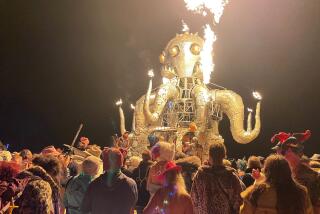Burning Man becomes a hot academic topic
Reporting from the Black Rock Desert, Nev. — Thousands of bare-chested women are riding bikes across the barren landscape of the Black Rock Desert outside Reno. They are being cheered on by crowds of enthusiastic, mostly male supporters.
“You’re beautiful!” shouts a tall, dreadlocked man in a pink tutu to Neko, a 21-year-old political science student from San Diego. “Be strong!” yells another, wearing a camera around his neck. For Neko, it’s the empowering highlight of her trip to Burning Man, the annual arts-and-fire festival that celebrated its 25th year this summer.
“It was women celebrating being women,” said the petite brunette, who like others here prefers to use her Burning Man nickname during the festival. “It was amazing.”
Where some see feminist freedom in the topless bike ride, researcher Wendy Clupper saw a dissertation. Watching the same parade eight years earlier, she couldn’t help noticing the dichotomy between female empowerment and male lust.
Her paper, “The Performance Culture of Burning Man,” earned Clupper a doctoral degree in performance arts from the University of Maryland. Since then her essays on Burning Man have been reprinted in two books, including an analysis of the bike ride that Neko found so exhilarating.
That puts Clupper among a growing list of sociologists, business professors, theologians and other scholars who view the event’s mix of hipsters, artisans, zany theme camps and outdoor art gallery as more than a party. They see fertile ground for research.
When she started her dissertation in 2002, Clupper could find only six other scholarly works focusing on Burning Man. Today there are dozens, including an expanding roster of analytical books.
Not since Woodstock’s “3 days of peace and music” in 1969 has a festival captured the attention of so many in U.S. academia. Just as they did decades ago, scholars are asking whether Burning Man is a window to a new kind of community or a Utopian dream destined to crash and burn.
Stanford business professor James Phills is preparing a mini- documentary exploring the values that prompt festival-goers to spend small fortunes creating art and building villages that they share freely with strangers.
Harvard-trained sociologist Katherine K. Chen wrote the book “Enabling Creative Chaos,” along with several academic papers, detailing the event’s evolution from a weekend camping trip on a San Francisco beach into an unconventional corporation with a $10-million budget and 2,000 volunteers.
For Cal State Northridge religion and anthropology teacher Lee Gilmore, the draw was the spiritual nature of the festival. In her new book, “Theater in a Crowded Fire: Ritual and Spirituality at Burning Man,” Gilmore explores the rituals, elaborate costumes, temples and fires of Burning Man and asks why the festival sometimes “smells like religion.”
Other books include “AfterBurn: Reflections on Burning Man,” a compilation of academic essays published by the University of New Mexico Press in 2005; “Festivalising!: Theatrical Events, Politics and Culture,” published in 2007; and “Political Performances: Theory and Practice,” published last year.
Clupper’s decision to use Burning Man for her studies was easy, she said.
“You’d never see this much art in a gallery. You’d be hard-pressed to find this many artisans in any performance space in the world,” said Clupper, who runs an avant-garde theater in San Francisco. “And yet you can come to one place and be inundated by it for one week.”
Larry Harvey, one of the founders, mused about the festival’s growing influence during first-ever “academic cocktails” held at this year’s event. “I don’t think anyone’s offering a degree in Burning Man yet,” he said, dragging on a cigarette. “But it’s shooting its flames all over the place.”
Festival-goers are encouraged to be “radically self-reliant,” bringing in everything needed to survive the harsh desert climate and then leaving without a trace. They observe a “gift economy,” sharing food, cocktails, back rubs, even solar showers. Commerce is not allowed, except sales of ice and coffee. There’s no advertising, and admission is $300, whether for a day or a week.
Academics who have immersed themselves in Burning Man culture year after year are finding that there may be something unusual going on with all of this. People freed from the conventions of the mainstream art world can create works of staggering beauty. Passion for a cause inspires hard work, volunteerism and community.
One professor concluded that Burning Man is an “organizational mutant,” not quite a business or a nonprofit, that has found a way to stage an anything-goes festival that is both highly organized and financially self-sustaining.
Phills, the Stanford professor, was only vaguely aware of Burning Man when a college friend, an investment banker, asked him to attend.
“I said to him, ‘Dave, isn’t that a party with sex and drugs and rock ‘n’ roll in the desert?’ He became pretty indignant and proceeded to give me a long lecture on the social values of Burning Man,” Phills said. “I thought, social values?”
Three festivals later, Phills sees lessons for entrepreneurs, nonprofits and anyone who wants to run a socially responsible business. The event fosters a willingness to be more creative and more community-minded, he said, and to work hard for a shared goal. Google Inc. founders Sergey Brin and Larry Page, festival veterans, have said they give extra weight to job applicants who have been to Burning Man.
Chen, the sociologist, said it was neither too hierarchical nor too loose in structure. Ideas come from its large volunteer ranks or from participants, who then find the muscle and cash to make it work (a recycling camp came about this way). Besides providing infrastructure, the festival’s small, year-round staff offers grants for large artworks and coordinates off-site projects, such as Burners Without Borders, a nonprofit that helps out in disasters.
Chen’s 2009 book, “Enabling Creative Chaos,” looks at the event’s success in detail.
“You have volunteers ranging from followers of punk-rock circuses to scientists working for NASA,” she said. “They like the freedom of finding their place instead of being told what to do.”
To Gilmore, the Cal State Northridge lecturer, the festival is an ideal laboratory for exploring the nature of religion. Burning Man, she said, shows how spiritual feelings emerge in settings not typically defined as religious.
Many “burners” — as regulars are known — view the week-ending ritual of torching the effigy as a deeply meaningful climax. A temple that is built each year for people to leave notes for lost ones, and then ritually burned, can also be viewed in a religious light, she said.
Many of the art projects have religious overtones too.
“There is something about it that lends itself to self-exploration and forming community,” Gilmore said. “For a lot of people there is something transcendent about it.”
But does it last?
For all of its love-fest vibes, there are moments when Burning Man seems a lot like what burners call the “default world.” Bike thefts are rampant, and Nevada police comb the dance palaces at night looking for drugs.
Violent crime is virtually absent, but veterans say it’s common for people to steal things from camps. And every year, longtime burners grouse that the event is becoming too commercial or too accepting of just-out-for-trouble yahoos.
The give-peace-a-chance ethos was tested this year on the night the Man burned. Volunteer rangers ordered those sitting in the zone where ash and embers would fall to remain seated for their safety. That set off a group of drunken young men.
“This is a pagan celebration, not Disneyland!” screamed one of the men, wearing fur chaps and a bandanna over his mouth. “Go back to your RVs and watch it on YouTube next week!”
Others in the crowd chided them for being “negative” and the men eventually cooperated. The minute the burning man fell to the ground in a fiery heap, the crowd went wild, rushing toward the bonfire and dancing gleefully.
Phills, Chen and Gilmore were among the many watching. “Yes, it’s a party,” Gilmore said. “But it’s more than a party.”
catherine.saillant@latimes.com
More to Read
Sign up for Essential California
The most important California stories and recommendations in your inbox every morning.
You may occasionally receive promotional content from the Los Angeles Times.











